September 2008 Cub Scout Roundtable Issue |
Volume
15, Issue
2
October 2008 Theme |
Theme:
Adventures in Books
Webelos:
Citizen and Showman
Tiger Cub
Achievement 5 |
WEBELOS
Get your Year off to a good start –
«
Go On a Webelos Overnighter or
Go to a Webelos Woods weekend!!
«
Attend Outdoor Webelos Leader
Training and learn what it's all about!
CITIZEN
COMMUNITY GROUP
Remember – Citizen is a required Activity
badge for the Webelos Badge. CD
For more ideas, be sure to check out last month's issue of Baloo for the
new Buddies theme. CD
Santa Clara County Council
Citizens have responsibilities and duties to their country. In the Cub Scout
Promise, Webelos Scouts say they will do their duty to their country. Good
citizens learn about their community, show respect for their flag, and show
respect for the rights of other people.
The Citizen Activity Badge is
intended for two consecutive months of Den Meetings.
Ideas For Den Activities
«
Pretend that your den is starting a new government.
«
Have the boys make their own flag.
«
Learn more about your community.
«
Teach the Wolf and Bear dens how to do a flag ceremony.
«
Plan and make a display on citizenship for Pack meeting.
«
Invite a highway patrolman or policeman to come to your den and
talk about being good citizens.
«
Invite a new American citizen to come and talk to the den about
his or her experiences in becoming a United States’ citizen.
Games And Activities
UNITED STATES GAME
ü
Have each boy make a list of all the states he remembers.
ü
After 5 minutes the one with the longest list wins.
UNITED STATES PRESIDENT GAME
This game is much like the United States Game, but instead
of naming states they are naming United States Presidents. After 5 minutes (or 2
or 3 minutes), the one with the longest list wins.
GEOGRAPHY GAME
P
Divide into teams.
P
One team picks out a place on the US map.
P
They call out the name and challenge the other team to find it in
2 minutes.
P
If the other team finds the location in the time limit, that team
gets a point.
P
If they do not find the location, then the team that chose the
location gets the point.
P
The game ends when one team has 5 points (or as many points as you
want to play to).
SCOUT LAW STUDY GAME
Materials: Scout Law written out (on paper,
chalkboard, white board, etc), a current newspaper copy (one per team), scissors
«
Divide the Webelos Scouts into teams, each with the same day's
issue of a newspaper.
«
On the signal, the teams start a search for news items that
illustrate the twelve points of the Scout Law [A Scout is Trustworthy, Loyal,
Helpful, Friendly, Courteous, Kind, Obedient, Cheerful, Thrifty, Brave, Clean
and Reverent.].
«
The Scouts then cut out the articles.
«
The team with the most clipped articles wins.
«
Then, have a spokesman from each team discuss why they chose the
articles they did and how those articles do illustrate the Scout Law.
FLAG FOLDING RELAY
ü
Divide the boys into two teams.
ü
Give each team a 3-by-5-foot flag.
ü
On a signal, the first boy hands the star side of the flag to the
boy behind him and folds the flag.
ü
After it is folded, the second boy unfolds the flag and hands the
star side of the flag to the boy behind him while he now folds the flag.
ü
Play continues until each boy has folded the flag.
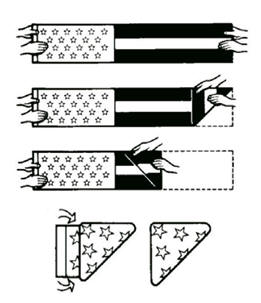
CITIZEN SCAVENGER HUNT
Most government buildings have
some form of a tour. You might be able to combine the tour with your scavenger
hunt.
Divide the den into two or
three teams and give the boys a reasonable time limit. Have them locate answers
to questions as well as inexpensive available items.
Examples for these would be:
·
What is the middle initial in the full name of our town' mayor?
What does the initial stand for?
·
Bring back a piece of stationery showing our town's logo or crest.
·
Draw a picture of our state flag.
·
Where does the City Council meet?
·
What is the full name of the governor of the state?
·
Get a brochure or find out some information about trash pick up
service?
·
Where in or on what floor of City Hall can you find __________?
·
Who runs the Water Department (or something else if you
don't have one. We don’t where I live CD) and what does that department
do?
·
What's on the top floor of the City Hall building?
·
Who takes care of snow removal/tree removal from city streets and
what is their budget?
A NEW GOVERNMENT – IN 3 DEN
MEETINGS
Den Meeting 1
Tell your Webelos that a new
large island has been found near Hawaii. You and your Webelos Scouts have been
asked to settle this island and form a new government. Each Webelos Scout will
establish his own city within his own territory.
Before den meeting, create a
simple map of the island (include contour lines if possible). Show the boys the
map and let each boy pick out his own territory. Start having the boys to
determine the name of their island country and the names of each territory.
Send home with each of your
Webelos Scouts, an 18” by 18” piece of white linen material and some heavy wire.
The material is for making their territorial flag. Boys could begin on designing
their flags with markers, paints, etc.
Each Webelos Scout should also have a list of the following
types of government (you can add more if you’d like):
Monarchy
Dictatorship
Democracy
They should return the following meeting with definitions
of each of these.
Den Meeting 2
Have the Webelos Scouts put
their flags on display when they first arrive (a clothes line across the room is
great).
Discuss with the Scouts the
government they want for their country (hopefully they have a name now). Try to
encourage the different forms of government... Voting is a fun part. You could
suggest that only people who own Fords can vote.
After your Webelos Scouts have
decided who gets to vote, then they need to decide if it will be an open or
closed ballot. Once they do that, they’ve made their first two laws.
Next they can vote for two
flags. Tally the votes and the winning flag just determined the location of your
capitol.
Den Meeting 3
The Webelos Scouts will get
hungry, so you’ll need to talk about what foods are growing on our island.
Coconuts? Sugar cane? Will anything else grow there? Are there animals there?
If we’re trading with other
countries, perhaps we’ll need to establish a foreign policy. We’ll need a
Commerce Department to work out the transportation of our sugar cane and
coconuts. Maybe we could trade with Japan from some Toyota trucks.
We can’t trade coconuts for
trucks, so we’ll need a monetary system. We’ll call that the Treasury
Department. What will our currency be called?
All these things and more can
be discussed and decided by the Webelos Scouts... and be presented in Pack
Meeting, too!
STUFF TO DO AND MAKE
DRAWINGS OF THE U.S. FLAG
Show the boys how to draw historic U.S. flags. (Show them a
picture and see if they can draw it). While they draw and color, you can tell
the story behind each flag.
HISTORY OF THE U.S. FLAG
Many different flags have represented the United States at
one time or another. But all the flags, and what they represent led up to the
current flag, which was adopted in 1960 with the addition of a star representing
the state of Hawaii, the nation’s 50th state.
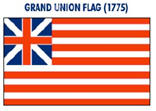
The Grand Union Flag (also known as the Continental flag)
was the first flag chosen by George Washington to be flown at the commemoration
of the Continental Army on New Year’s Day, 1776. It is a combination of the
British King’s Colors and the thirteen stripes signifying colonial unity.
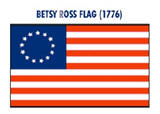
Betsy Ross, a seamstress from Pennsylvania, has been
credited with creating the first Stars and Bars, though some people question
whether she did or not. As the legend goes, George Washington appeared on Mrs.
Ross’ doorstep in June of 1776 with two representatives of Congress. They asked
that she make a flag according to a rough drawing they carried with them. At
Mrs. Ross’ suggestion, Washington redrew the flag design in pencil in her back
parlor to employ the stars of five points instead of six points.
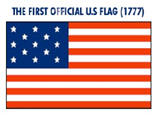
Since there was no official flag during the first year of
the United States, there were a great number of designs. The Betsy Ross Flag is
the most well known of those, but the United States did not choose its first
official flag until June 14, 1777 with the passing of the first Flag Act.
This 13-Star flag became the Official United States Flag on
June 14, 1777 – which is why we celebrate Flag Day as June 14th every year. The
only president to serve under this flag was George Washington. It was our
official flag for 18 years.
Each star and stripe represented the 13 Colonies, which
were united in 1776 by the Declaration of Independence.
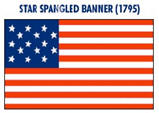
When Vermont (the 14th State in 1791) and Kentucky (the
15th State in 1792) joined the United States, a new flag was needed. Two stars
and two stripes were added and the Star Spangled Banner became the new Official
United States Flag in 1795. It had 15 stars and 15 stripes – the only flag to
have more than 15 stripes. It was flying in 1814 over Fort McHenry when Francis
Scott Key wrote our National Anthem.
In 1818, Congress decided that it wasn’t practical to add a
new stripe for each new State, and so they passed the Flag Act of 1818 that made
the flag have 13 stripes and they specified that a new star would be added for
each state. This is the standard that is still used today.
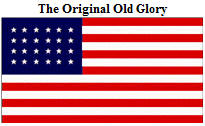
On July 4, 1822, the 24-star flag became the sixth “Stars
and Stripes” to fly over the United States of America. “Old Glory”, at first
was a single flag the bore the name now familiar to us all. The flag belonged
to Sea Captain William Driver. He received the flag in 1824. At that time he
was about to sail from his homeport of Salem Massachusetts, on one of the trips
that took him around the world. From that date on, the flag went with him on
his ship “Charles Doggett” whenever he went.
In 1837, after countless voyages, Captain Driver retired
from the sea and went to live Nashville Tennessee. Of course, he took his flag
with him and displayed it on holidays and on St. Patrick’s Day (March 17th, his
birthday as well). He and his flag became well known in Nashville.
When to Civil War broke out those who hoisted American
Flags in Nashville were attacked by Southern sympathizers. Confederate soldiers
searched Driver’s home on several occasions for his flag, but never found it.
When Union forces entered the city, Driver ripped open a bedspread and revealed
his flag that had escaped any harm. Seeing it float from the top of the Capitol
building in Nashville, Driver declared “I am ready to meet my forefathers
knowing ‘Old Glory’ and Tennessee have been saved for the Union”.
After the war, the story of Captain Driver’s flag and its
name spread by word of mouth and in books and newspapers. Although there is
doubt about whatever happened to Old Glory, its name lives in the hearts of
Americans.
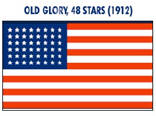
By July 4, 1912, the United States flag had 48 stars.
President Taft, established proportions for the flag and provided for
arrangement of the stars in six horizontal rows of eight each – with a single
point to be upward.
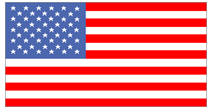
Today, whatever you choose to call it, it has 50 stars one
for each state of the Union. It is the 27th Official Flag of the United States
of America -- Our Flag.
CUT A 5 POINTED STAR IN ONE
SNIP
According to the story, George Washington's original pencil
sketch for the flag indicated 6-pointed stars, a form he apparently preferred.
Betsy Ross, however, recommended a 5-pointed star. When the committee protested
that it was too difficult to make, she took a piece of paper, folded it deftly,
and with a single snip of her scissors, produced a symmetrical five-pointed
star. This feat of magic so impressed her audience that they readily agreed to
her suggestion.
It is easy to do, go to
http://www.ushistory.org/betsy/flagstar.html
This is on the Official Betsy Ross Homepage or Website
There are excellent instructions.
The key is using an 8 1/2 by 10 inch paper (not 8 1/2” x
11” – it will work, but it won’t be “perfect” star!).
And take
time to explore the whole site!!! CD
More on the Citizen Activity
Badge
This is a good badge to start
the boy on when he joins the Den. The written requirements and readings may be
done at home with parents. This continues the importance of parents involvement
in the Webelos Den.
This badge is also of interest
to the leader, because he can learn much about his boys from their writings on
what is meant by "all men are created equal" and on the Star Spangled Banner.
The leader should keep in mind that all boys are different, so they will have
different ideas and opinions on this badge. Each boy's "BEST" should be judged
individually.
A lot will depend on how well
informed and enthusiastic the Webelos leader is, and how he presents the badge
to the boys. This badge can be fun, or it can be just '`another piece of paper
to write." It's up to you.
One of the purposes of Cub
Scouting is "Developing habits and attitudes of good citizenship". A Scout
promises to do his duty to his country. The Citizen Activity Badge helps the
WEBELOS understand what a good citizen is and teaches him the history of our
flag. Citizen Activity Badge is in the
OBJECTIVES
·
To foster citizenship in WEBELOS Scouts.
·
To teach boys to recognize the qualities of a good citizen.
·
To introduce boys to the structure of the U.S. government.
·
To familiarize boys with basics of American history.
·
To convince boys that laws are beneficial.
·
To encourage WEBELOS Scouts to become community volunteers.
Den Activities
ü
Discuss requirements of badge with boys. Decide on a good turn for
school, church or community and plan how to carry it out. Boys make logbooks to
record their work on the badge.
ü
Plan a special good turn for the next Pack meeting; such as
setting up chairs, ushering, clean-up, etc.
ü
Visit a local government agency. Find out how it works, what
service it provides, how it affects boys and their families.
ü
A campaign against litter is a "must" for good citizenship.
Discuss how your Den can carry on such a campaign.. and do it. This could
include making posters for display. litter clean-up, making litter bags, etc.
ü
Discuss the various organizations in your community, which help
people. How are they financed and run? Do they use volunteer help? Visit one of
these organizations.
ü
Discuss ways boys can be good citizens. Let them make lists of
things they will try to do regularly.
Your Duties as a Citizen
If you are going to have rights as a citizen and you want
to keep them, then you also have certain duties to uphold. Your duties as a
citizen are:
«
Obey the laws
«
Respect the rights of others
«
Keep informed on issues of National and local government
«
To vote in elections
«
To assist the agencies of law enforcement
«
To practice and teach good citizenship in your home Some qualities
of a good citizen:
«
Obeys the laws wherever he is
«
Respects the rights of others
«
Is fair and honest
«
Tries to make community a better place to live
«
Learns about leaders of nation, state, community
«
Practices rules of health and safety
«
Is honest and dependable
«
Is patriotic and loyal
«
Practices thrift
«
Respects authority
Great Documents Quiz
How much do you know about two of the greatest documents
ever written: the Declaration of Independence and the Constitution of the United
States?
1:
The first words of the Declaration of Independence are:
A)
"We hold these truths to be self evident..."'
B)
"We, the People of the United States..."
C)
"When in the course of human events..."
D)
"Four score and seven years ago...""
2:
The first draft of the Declaration of Independence was written
by:
A)
John Hancock
B)
Button Gwinnett
C)
George Washington
D)
Thomas Jefferson
3:
The Constitution of the United States was signed in What year?
A)
1776
B)
1492
C)
1787
D)
1620
4:
What is the minimum age for a President of the United States,
and in what document is this stated'?
5:
Which amendment to the Constitution provided for the abolition
of slavery'?
A)
Tenth Amendment
B)
Thirteenth Amendment
C)
Third Amendment
D)
Sixteenth Amendment
6:
A Senator serves a term of:
A)
Six years
B)
Four years
C)
Two years
D)
Light years
7:
What is the maximum number of years a President may serve?
8:
Which amendment to the Constitution guarantees freedom of
speech:
A)
Fourteenth Amendment
B)
First Amendment
C)
Twenty-ninth Amendment
D)
Fifth Amendment
9:
What legislative body has the sole power to impeach a
President?
Answers:
1-c, 2-d, 3-c,
4-Age 35. as stated in the Constitution, 5-b,
6-a, 7-Ten years (two terms plus the remainder of a predecessor's term if 2
years or less),
8-b, 9-House of Representatives
On Your Mark
Mark the best ending for each sentence.
1:
If you meet the president, you call him:
A)
your highness
B)
your Excellency
C)
Mr. President
2:
The president and his family live in:
A)
Blair House
B)
the White House
C)
the suburbs
3:
The first president to live in the White House was:
A)
John Adams
B)
George Washington
C)
"Thomas Jefferson
4:
We celebrate the birthdays of two presidents in February they
are:
A)
Washington and Lincoln
B)
Jefferson and Adams
C)
T. Roosevelt and F. D. Roosevelt
5:
During the War of 1812, when Madison was President, a famous
song was written. It is called:
A)
The Battle Hymn of the Republic
B)
God Bless America
C)
The Star Spangled Banner
6:
The only man to be elected president four times was:
A)
Abraham Lincoln
B)
Franklin Delano Roosevelt
C)
Ulysses S. Grant
7:
The two big political parties today are called:
A)
the Republicans and the Democrats
B)
the Federalists and Whigs
C)
the Conservatives and the Liberals
8:
The law says Presidential elections must be held on:
A)
the first Monday in October
B)
the first Tuesday in November
C)
Halloween .
9:
The parties pick their presidential candidates in:
A)
presidential primaries
B)
national nominating convention
C)
by secret vote
10:
If a president dies in office the next president is:
A)
the vice president
B)
elected by the people
C)
the oldest senator
11:
Presidential elections are held every:
A)
two years
B)
four years
C)
six years
12:
If you want to run for president you should:
A)
go jogging
B)
take a nap
C)
make speeches
13:
The United States is made up of:
A)
50 states
B)
48 states
C)
46 states
14:
Twenty-seven presidents have studied:
A)
flying
B)
the stars
C)
the law
15:
The presidents wife is called:
A)
the queen
B)
the first lady
C)
Mrs. President
Answers:
1-c, 2-b, 3-a,
4-a, 5-c, 6-b, 7-a, 8-b,
9-b, 10-a, 11-b, 12-c, 13-a, 14-c, 15-b
Patriotic Wall Plaque
Using a copy of the Declaration of Independence, Bill of
Rights or the Gettysburg Address; make a wall plaque by mounting one of these on
1/4" plywood shaped into the design of a scroll. Make your scroll slightly
larger than your copy. Finish plywood by sanding, staining a natural color and
varnishing or leave the wood grain and color show through by eliminating stain
and just varnish.
Where to go and what to do
P
Invite a guest speaker from a local board to explain his duties
and tell the WEBELOS Scouts why he volunteers his time.
P
Buy a packet of used U.S. commemorative stamps. Distribute several
to the WEBELOS Scouts and challenge them to discover the "story behind the
stamp". At the following meeting allow each boy ample time to describe his
stamps and their significance.
P
Attend a local city council meeting.
P
Do a Good Turn by conducting a litter pickup campaign
P
Have each WEBELOS Scout write a letter to his Senator or
Congressman to express an opinion on an issue. It would be especially
interesting if two WEBELOS Scouts wrote an opinion about opposite sides of the
same issue. See what responses you receive.
P
Encourage WEBELOS Scouts to fly a flag at home particularly on
appropriate flag holidays.
P
Arrange for the WEBELOS den to do a community service project.
Good turn ideas
·
Give some of the toys the WEBELOS Scouts may have made as part of
the Craftsman badge to needy children. Use Craftsman skills to repair and
refurbish toys for the same purpose.
·
Give a holiday party for children or adults in a residential
situation. Plan games, songs, small gifts, party favors, and treats
·
Participate in the Food Drive in the fall to stock good pantries
for needy families
·
Collect toilet articles and used clothing for the homeless
·
Salvage used books to be sold at the public library or to be used
to set up libraries for children or adults in a residential situation
·
Read to someone who cannot see.
·
Provide snow shoveling, yard care, errand service, or other aid to
an elderly person or couple in your neighborhood.
DO YOU KNOW YOUR FLAG?
When the Stars and Stripes first became our national flag,
no one was sure just what the design of the flag should be. Since the time of
that first flag, official descriptions of the national colors have been very
careful and clear. Not only is the design of the flag carefully described today,
but there are many special rules for displaying it. The following questions are
based on the universal flag code of the United States. See how many you and your
WEBELOS den can answer correctly. Some of these questions are tricky.
1)
The flag is raised (a) slowly; (b) briskly; (c) at any speed
that is comfortable.
2)
If you carry the flag in a parade and passed before the
President of the United States, you would dip the flag slightly in salute to the
President as you walked past him. True or False?
3)
The flag must never be lowered no matter how bad the weather
conditions. True or False?
4)
The flag is never allowed to fly after daylight hours anywhere
in the world. True or False?
5)
When the flag is carried in a procession or on other
occasions, it is escorted by an honor guard. True or False?
6)
The flag's honor guard walks (a) on the flag's right; (b) just
behind the flag; (c) on both sides of the flag.
7)
If you are a Cub Scout, WEBELOS Scout, Boy Scout, or Explorer,
you always give the Cub Scout, or Explorer salute to the flag even when you are
not in uniform. True or False?
8)
When you carry the flag in a parade with other flags, the U.
S. flag must go on the left of and in line with the other flags. True or False?
Answers:
1)
(b) briskly - it's a happy occasion!
2)
False. The flag is never dipped to anyone..
3)
The U.S. Code states, "The flag should not be displayed on
days when the weather is inclement, except when an all weather flag is
displayed." All-weather flags are specially made to resist the elements and are
generally labeled as such by flag manufacturers. Even flags labeled as being
all-weather flags, however, can be damaged by high winds and extreme
conditions. We recommend good judgment when determining whether a flag should
remain flying during bad weather.
4)
False. Although it is the custom to display the flag only from
sunrise to sunset, there is no law prohibiting its being flown both day and
night.
5)
True.
6)
(c) on both sides of the flag.
7)
False. When you are in civilian clothes, you remove your hat
and place your hand over your heart when the flag passes
8)
False. It is carried at the right of the other flags or at the
front and center of a line of other flags.
Den Activities
One way to make this activity badge come alive is to get
involved. A good citizen gets involved where he lives. Your involvement can
start at any age and it can be almost any useful act. Now is a good time to plan
a citizenship project for your Webelos den.
·
Clothing Drive
·
Often after a fire, flood, or other disaster many people will be
without sufficient clothing. Generally, local authorities coordinate a campaign
to get used clothing in serviceable condition for distribution to the victims.
Councils and districts should cooperate with local authorities and not attempt
to set up an independent project.
·
Get-Out-The-Vote Campaign
·
A natural follow-up to registration campaign is an effort to get
every eligible voter to vote. This calls for an educational and promotional
campaign aimed at reminding citizens of their right and duty to vote. The
campaign must be non-partisan. Before the election distribute get-out-the-vote
materials. On election day, Scouts may be stationed outside polling places to
"baby-sit" young children, hold packages, assist elderly or handicapped people,
and provide "I have voted" badges to voters, leaving them as a reminder to
others.
·
Mark Homes for Disabled Persons
·
In cooperation with fire departments, install amber reflectors (or
other distinctive devices) over the front doors of homes where handicapped
persons live. Then if a fire breaks out, the firefighters will know immediately
that a handicapped person lives there. A similar device may be placed on the
door of the person's bedroom to help firefighters find it in an emergency. Fire
departments generally provide the insignia, usually placed on the front
downstairs window near the door or on the glass of the front door. A similar
device is placed on the window of the invalid's room. Caution: Be sure you have
approval of everyone living in that home before you place markers.
·
Collect Christmas Toys
·
In many communities, new and used but still usable toys are
collected for` distribution to needy children at Christmas. Units may assist by
making pickups of toys, making posters to advertise the campaign, helping to
stockpile toys, cleaning and repairing used toys, and delivering toys to the
agencies that distribute them to poor children. Each youth member may also be
asked to contribute one usable toy.
Flying Flags
«
Buy a bulk of small plastic flags.
«
Divide them up to all the den members during the closing ceremony.
«
Tell them to carry the flags around this week and give them to
people who are being "Good Citizens," explaining why.
Duties & Rights
Complete each line by inserting duty or right in the blank.
Every Citizen has ...
The_______ to obey all laws.
The_______ to equal protection of laws and equal justice in the courts.
The_______ to respect the rights of others.
The_______ to inform yourself on issues of government.
The_______ to be free of arbitrary search and seizure.
The_______ to equal education and economic opportunity.
The_______ to serve on a jury if called.
The_______ to vote.
The_______ to own property.
The_______ to vote in elections.
The_______ to serve and defend your country.
The_______ to free speech, press, and assembly.
The_______ to assist agencies of law enforcement.
The_______ to a lawyer of your choice and a prompt trial if accused of a crime.
The_______ to practice and teach the principle of good citizenship in your home.
Answers
1. Duty, 2. Right, 3. Duty, 4. Duty, 5.
Right,
6. Right, 7. Duty, 8. Right, 9. Right, 10.
Duty,
11. Duty, 12. right, 13. Duty, 14. Right, 15. Duty
SHOWMAN
MENTAL SKILLS GROUP
Greater St. Louis Area Council
The
Showman Activity Badge offers a choice of puppetry, music, or drama. A WEBELOS
can pick the area that suits him best. Showman Activity Badge is in the Mental
Skills group.
The
Showman activity badge has something for every Webelos scout. For the natural
actor there is drama, for the shy boy there is puppetry, and for every boy there
is music. The aim of the badge is not to produce skilled entertainers, but to
expose boys to theater and to music arts, to help them build self-confidence,
and of course, to have fun. Everyone loves a show and most all boys have a
generous chunk of ham in them and want nothing better than a chance to let it
out. If you don't give them a chance under controlled conditions, they will take
it when you least expect they want it.
The
Showman activity badge gives them a chance to let out the hidden barely
Shakespeare, Jerry Lewis, Leonard the Great or what ever happens to be their
style. It allows them to express themselves musically be it kazoo or Steinway.
Providing the entertainment for the pack meeting will be a challenge gladly met
by Webelos Scout boys and the sillier the better! The badge covers most of the
field of entertainment and acquaints the boys with ways of putting on various
shows or skits. Making the props also can be used as part of the Craftsman
badge. Skits and Songs are covered elsewhere in the Bugle. Every conscientious
leader of boys is working to further develop the whole boy- physically,
emotionally, spiritually, and mentally so he will be prepared to take his place
as a well-adjusted member of his social group. The Showman badge offers the
opportunity for a boy to develop his creativity and broaden his base of
aptitudes.
Objectives:
ü
To instill an appreciation of the fine
arts.
ü
To expose boys to entertainment
professions.
ü
To expand the imagination and
creativity of WEBELOS.
ü
To increase boys' self-confidence in
front of audiences.
Pack and Den Ideas
ü
Junior and Senior high school plays.
ü
Make
up a Webelos band to entertain at a pack meeting.
ü
Learn
magic tricks to do as a skit. Or take your magic show on the road to a
residential center for seniors or children.
ü
Make
a video tape of a play the WEBELOS write and perform. Show it to parents or in a
demonstration corner of a pack meeting.
ü
Invite
an artist, and/or a musician to a den meeting to tell about their profession or
hobby.
ü
Write
and/or perform a skit complete with scenery and costumes.
ü
Attend
a folk music festival. Learn to sing a folk song. Learn about the history of the
song.
ü
Invite
the boys to tell about the instruments that they play.
ü
Make
an audio tape of a radio program the boys perform.
ü
Invite
a drama teacher to speak
ü
Put
on a program for the pack meeting
ü
Make
puppets, write and put on a puppet show
ü
Visit
a nursing home and perform music
ü
Make
a stage and costumes for a play
ü
Make
some homemade band instruments - try to play a tune on them.
ü
Scouts
like silly or gross songs. (Songs about eating worms, etc. are great.)
ü
Invite
an actor or drama teacher to explain stage directions.
ü
Ask
a clown, actor, or make-up artist to show the den how to apply stage makeup.
ü
Learn
how to make sound effects.
ü
Learn
how to make other special effects, lighting.
ü
Videotape
a short movie.
ü
Invite
a high school drama teacher to explain and demonstrate make-up techniques.
ü
Attend
a high school play or concert.
ü
Ask
a Shriner clown to give a talk on clowning and give a demonstration.
ü
Write
a puppet play and make the puppets to act it out.
ü
Put
on an advancement ceremony for your Pack meeting.
ü
Talk
about sound effects and let the boys try some of them.
ü
Use
a tape recorder to tape the boy’s voices and let them hear how they sound.
ü
Visit
a TV or radio station and watch programming in action.
ü
Have
a story-telling session. Have each boy come prepared to tell the best true-life
story he knows about something that happened to himself or a friend or family
member. This is an opportunity to emphasize the importance of good listening and
the value of sharing ideas.
Ceremonies
Getting Started Opening Ceremony-
A
dramatization using four Webelos, who stand in a diagonal line at one side,
facing the audience, and the Webelos Leader, who is facing the Webelos and the
audience on the other side.
W.L.:
David, how would you set out to do a good turn?
(David takes one step forward.)
W.A.:
John, how would you get started on a camp out?
(John takes one step forward.)
W.L.:
Ray, how would you start on a hike?
(Ray takes one step forward.)
W.A.:
Mike, how would you start out to achieve your first activity badge?
(Mike takes one step forward.)
W.L.:
Yes, it is as simple as that to make a thousand mile journey, to run a race, to
learn a trade, to meet new people, to climb a mountain, to create a masterpiece,
to build sky-scrapers, to design a spaceship. Yes to do anything worthwhile,
there is always a first step, and it is the most difficult one to take.
WA: If
you are to progress in life, or in Tigers, Cubs, Webelos, or Boy Scouting, you
must first face your goal and then get started with that all important first
step!
(On the words FIRST STEP, all the boys take one step forward again and then
salute.)
The Athenian Oath Closing-
Cub # 1:
We will never bring disgrace to
this, our city, by any act of dishonesty or cowardice.
Cub # 2:
We will fight for the ideals and
sacred things of the city, both alone and with our companions.
Cub # 3:
We will revere and obey the city's
laws.
Cub # 4:
We will try unceasingly to quicken
the sense of civic duty in others.
Cub # 5:
In every way, we will strive to
pass the city on to our sons, greater and better than it was when our fathers
passed it on to us.
Skits
Putting on a Skit
The Cub Scout literature has poems and stories that
can be used for skits, but the public library has a lot more material. Ask your
librarian for directions to the literature the theater sections of the library.
The youth or juvenile sections of the library also has material that is more
suited to the age of the Webelos Scout. A good skit is really a play in one act
and can be more readily handled by 9 and 10- year-old boys. The Cub Scout How to
Book contains some good ideas on how to write your own skit or one act play. Let
the Cub's be creative. They can make the play up about anything they are
interested in, sports, Scouting, a silly moment in the Den meeting, etc. Making
costumes and putting on "stage makeup" makes the task more fun and enjoyable.
Crafts
Face Paint-
Materials:
6 Tbsp
cornstarch
3 Tbsp
water
3 Tbsp
cold cream,
Food
coloring
6 c
muffin tin
Directions:
In
each cup of a muffin tin, put 1 teaspoon of cornstarch, 1/2 teaspoon each of
cold cream and water.
Add
a different color food coloring to each cup.
Glove Finger Puppet--"Three Little Pigs"-
Materials:
hot glue
gun (used by leaders),
scissors
garden
gloves
small
pom-poms (pink, gray & black),
large
pom-poms (same colors)
pink and
gray felt
googly
eyes
Directions:
Hot
glue large pom poms to finger tips-palm side of glove.
Glue on small pom poms for noses.
Then glue on ears and eyes.
Glue hat (cut from felt) on wolf and
Dot
nostrils on each pig with a black permanent marker.
Use your creativity to create other glove-finger puppets, like Goldilocks and
the Three Bears, Jack and the Beanstalk, etc.
Soda Straw Harmonica-
Cut
a strip of corrugated cardboard with large corrugations, 8" long and 1 1/2"
wide.
Cut
8 straws into the following lengths: 8 1/2", 73/4", 6 3/4", 6" 5 1/4", 4 1/2" 4
1/4"
Push the straws between the sections of the cardboard beginning about 1/2" from
one end and leaving four empty corrugations between straws.
The
shorter the vibrations, the higher the pitch.
To
play, blow over the straws.
Tin Masks-
Materials:
Scissors
Sharp
nail
Aluminum
pie pans (9" or larger and 4" pot-pie size),
Brass
fasteners (various sizes)
Directions:
1.
Using the 9" size pan as the base
for the mask, have the Scouts imagine all the facial features that might appear
on the mask. Have them draw out a design for their special creation.
2.
If any embossed design is used,
place the pan on a stack of newspaper for support. Using the nail or a
ball-point pen, use firm, even pressure to draw the design on the plate. Enough
force should be used to bend the plate out on the other side, but be careful not
to puncture to pan.
3.
Cut shapes for added features from
other pans. The pot-pie size is great for this part. The shapes can be cut from
paper first to be used as a guide for cutting the tin.
4.
Use small brass fasteners to
connect the shapes to the base of the mask. Make small nail holes in the pieces
of the pan where they are to be connected. Push the fastener through both pans
to make the connection.
5.
Larger brass fasteners can be used
for additional decoration. Foil wrap or tinsel may also be used for details.
6.
Tape a tab ring pull from a soft
drink can to the back to use as a hanger for the mask.
Activities
Hooray for Hollywood!
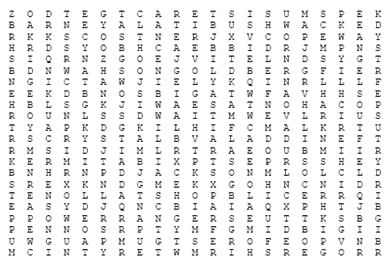
Find the capitalized words below in the puzzle above.
tom
HANKS robin WILLIAMS
mel
GIBSON danny GLOVER
whoopie GOLDBERG goldie HAWN
sally FIELD macauley CAULKIN
kevin COSTNER billy CRYSTAL
michael JACKSON sly STALLONE
OAK
RIDGE BOYS BEACH BOYS
TLC reba MCINTYRE
george STRAIT kenny ROGERS
ALADDIN PECOS BILL
HOME ALONE SISTER ACT
POCAHONTAS RICHIE RICH
BUSHWACKED FOREST GUMP
POWERRANGERS ANGELS / OUTFIELD
MUPPETS
BARNEY
jim
HENSON BIG BIRD
KERMIT
Materials found in Baloo's Bugle may be used by Scouters for Scouting activities provided that Baloo's Bugle and the original contributors are cited as the source of the material. |
|





